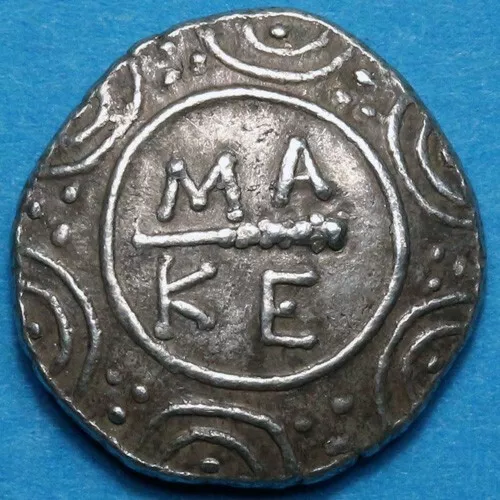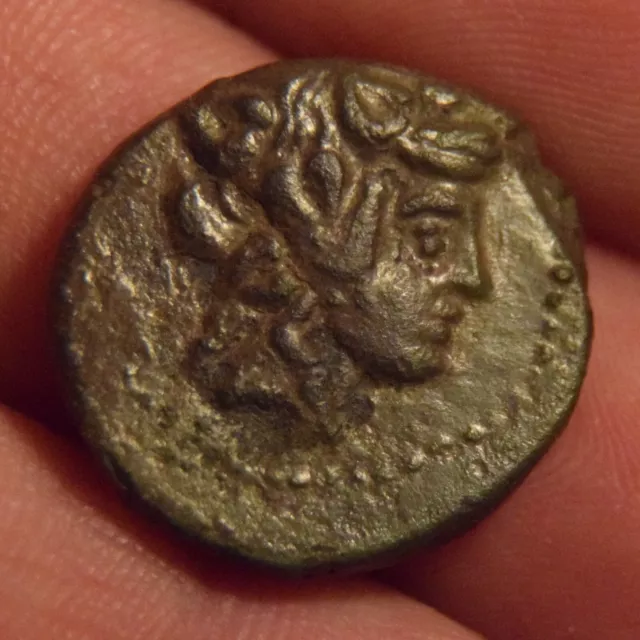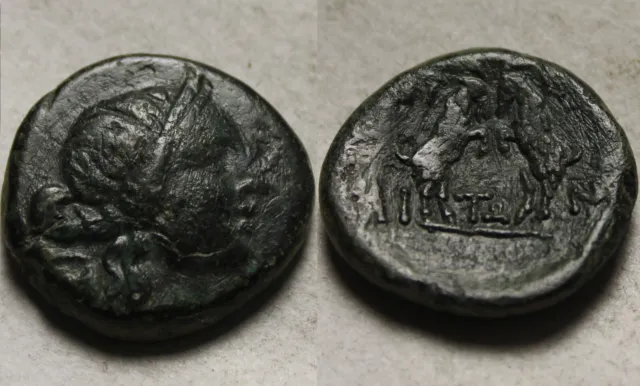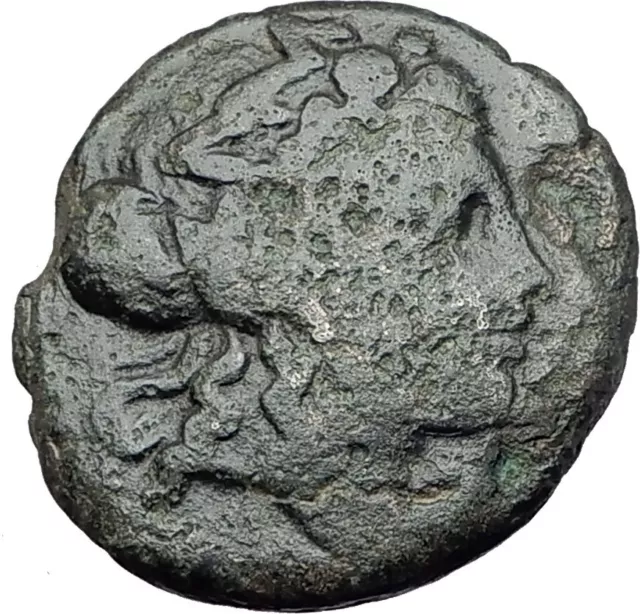Greek city of Thessalonica in Macedonia for District Amphaxitis Bronze 23mm (8.03 grams) Struck after 168/148 B.C. Reference: HGC 3, 339; AMNG 83-96 Head of young Dionysus right, wreathed with ivy. MAKE / ΔONΩN above and below goat standing right, AMΦ monogram (standing for "Amphaxian Macedonians") in field to right. Nothing is mentioned about the district Amphaxitis until about 217 B.C. when Philip V raised troops from there and the neighboring district of Mygdonia to make an assault on the Aitolian League at the end of the Social War (220-217 B.C. Amphaxitis translated to "On Both Sides of the Axios" and may probably included the territory at the mouths of the Echidoros and Axios rivers. The only major city in the district would have been Thessalonica. Thessalonica, more anciently Therma, an ancient city in Macedonia, situated at the N.E. Extremity of the Sinus Thermaicus. Under the name of Therma it was not a place of much importance. It was taken and occupied by the Athenians a short time before the commencement of the Peloponnesian war (B.C. 432), but was soon after restored by them to Perdiccas. It was made an important city by Kassander, who collected in this place the inhabitants of several adjacent towns (about B.C. 315), and who gave it the name of Thessalonica, in honor of his wife, the daughter of Philip and sister of Alexander the Great. From this time it became a large and flourishing city. Its harbor was swell situated for commercial intercourse with the Hellespont and the Aegean; and under the Romans it had the additional advantage of lying on the Via Egnatia, which led from the W. shores of Greece to Byzantium and the East. It was visited by Apostle Paula about A.D. 53; and about 2 years afterwards he addressed from Corinth 2 epistles to his converts in the city. Thessalonica continued to be, under the empire, one of the most important cities of Macedonia; and at a later time it became the residence of the prefect, and the capital, of the Illyrian provinces. It is celebrated at this period on account of the fearful massacre of its inhabitants by order of Theodosius, in consequence of a riot in which some of the Roman officers had been assassinated by the populace. You are bidding on the exact item pictured, provided with a Certificate of Authenticity and Lifetime Guarantee of Authenticity.
Dionysus is the god of the grape harvest, winemaking and wine, of ritual madness, fertility, theatre and religious ecstasy in Greek mythology. Alcohol, especially wine, played an important role in Greek culture with Dionysus being an important reason for this life style. His name, thought to be a theonym in Linear B tablets as di-wo-nu-so (KH Gq 5 inscription), shows that he may have been worshipped as early as c. 1500â€"1100 BC by Mycenean Greeks; other traces of the Dionysian-type cult have been found in ancient Minoan Crete. His origins are uncertain, and his cults took many forms; some are described by ancient sources as Thracian, others as Greek. In some cults, he arrives from the east, as an Asiatic foreigner; in others, from Ethiopia in the South. He is a god of epiphany, "the god that comes", and his "foreignness" as an arriving outsider-god may be inherent and essential to his cults. He is a major, popular figure of Greek mythology and religion, and is included in some lists of the twelve Olympians. Dionysus was the last god to be accepted into Mt. Olympus. He was the youngest and the only one to have a mortal mother. His festivals were the driving force behind the development of Greek theatre. Modern scholarship categorises him as a dying-and-rising god. The earliest cult images of Dionysus show a mature male, bearded and robed. He holds a fennel staff, tipped with a pine-cone and known as a thyrsus . Later images show him as a beardless, sensuous, naked or half-naked androgynous youth: the literature describes him as womanly or "man-womanish". In its fully developed form, his central cult imagery shows his triumphant, disorderly arrival or return, as if from some place beyond the borders of the known and civilized. His procession (thiasus) is made up of wild female followers (maenads) and bearded satyrs with erect penises. Some are armed with the thyrsus , some dance or play music. The god himself is drawn in a chariot, usually by exotic beasts such as lions or tigers, and is sometimes attended by a bearded, drunken Silenus. This procession is presumed to be the cult model for the human followers of his Dionysian Mysteries. In his Thracian mysteries, he wears the bassaris or fox-skin, symbolizing a new life. Dionysus is represented by city religions as the protector of those who do not belong to conventional society and thus symbolizes everything which is chaotic, dangerous and unexpected, everything which escapes human reason and which can only be attributed to the unforeseeable action of the gods. Also known as Bacchus , the name adopted by the Romans and the frenzy he induces, bakkheia . His thyrsus is sometimes wound with ivy and dripping with honey. It is a beneficent wand but also a weapon, and can be used to destroy those who oppose his cult and the freedoms he represents. He is also called Eleutherios ("the liberator"), whose wine, music and ecstatic dance frees his followers from self-conscious fear and care, and subverts the oppressive restraints of the powerful. Those who partake of his mysteries are possessed and empowered by the god himself. His cult is also a "cult of the souls"; his maenads feed the dead through blood-offerings, and he acts as a divine communicant between the living and the dead. In Greek mythology, he is presented as a son of Zeus and the mortal Semele, thus semi-divine or heroic: and as son of Zeus and Persephone or Demeter, thus both fully divine, part-chthonic and possibly identical with Iacchus of the Eleusinian Mysteries. Some scholars believe that Dionysus is a syncretism of a local Greek nature deity and a more powerful god from Thrace or Phrygia such as Sabazios or Zalmoxis.
The city of Thessalonica in Macedonia was founded around 315 BC by King Kassander of Macedon, on or near the site of the ancient town of Therma and twenty-six other local villages. King Kassander of Macedon named the new city after his wife Thessalonike, a half-sister of Alexander the Great. She gained her name ("victory of Thessalians", from Greek: nikē "victory") from her father, Philip II, to commemorate her birth on the day of his gaining a victory over the Phocians, who were defeated with the help of Thessalian horsemen, the best in Greece at that time. Thessaloniki developed rapidly and as early as the 2nd century BC, it had its first walls built, which enclosed and protected the city. The city also came to be an autonomous part of the Kingdom of Macedon, with its own parliament where a King was represented that could interfere in the city's domestic affairs. Roman era After the fall of the Kingdom of Macedon in 168 BC, Thessalonica as it came to be called in Latin, became a city of the Roman Republic. It grew to be an important trade-hub located on the Via Egnatia, the Roman road connecting Byzantium (later Constantinople) with Dyrrhachium (now Durrës in Albania), which facilitated trade between Europe and Asia. The city became the capital of one of the four Roman districts of Macedonia while it kept its privileges but was ruled by a praetor and had a Roman garrison. Also for a short time in the 1st century BC, Thessalonica even became capital for all the Greek provinces. Due to the city's key commercial importance, a spacious harbour was built by the Romans, the famous Burrowed Harbour (Σκαπτός Λιμήν) that accommodated the city's trade, up to the 18th century. Later, with the help of silt deposits from the Axios river, land was reclaimed and the port was expanded. Remnants of the old harbour's docks can be found in present-day under Frangon Street, near the city's Catholic Church. Thessaloniki's acropolis, located in the northern hills, was built in 55 BC for security reasons, following Thracian raids in the city's outskirts at the time. About 50 AD, while on his second missionary journey, Paul the Apostle reasoned with the Jews from the Scriptures in this city's chief synagogue on three Sabbaths and sowed the seeds for Thessaloniki's first Christian church. During Paul's time in the city, both Jews and Greeks came to believe the Gospel, as well as some of the city's leading women. However, because the remaining Jews at the synagogue were furious with Paul for what he'd done in their community and were also furious with those who had come to believe Paul's message, the Apostle and his traveling companions, Silas and Timothy, were eventually sent out of Thessaloniki during the night by the new Christian converts. From there the church planters went to Veroia, aka Berea, where the people in that city also heard and believed the Gospel. This so enraged the Thessalonian Jews when they found out what Paul and his companions had done, the Jews went to Berea and persecuted the evangelists in that city also. The three men eventually continued their travels and ministry; and, Paul wrote two letters to the new church at Thessaloniki, probably between 51 and 53, the First Epistle to the Thessalonians and the Second Epistle to the Thessalonians. These letters were to encourage the new believers to persist in the faith in the face of strong opposition, to encourage personal sanctification, to encourage them about those who had "fallen asleep," yet to warn about the Lord returning as a "thief in the night" and to correct incorrect thinking about the coming Antichrist, among writing about other important matters. In 306, Thessaloníki acquired a patron saint, St. Demetrius. He is credited with a number of miracles that saved the city and was the Roman Proconsul of Greece, under the anti-Christian emperor Maximian. St. Demetrius was martyred at a Roman prison, where the Church of St. Demetrius lies today. The church was first built by the Roman sub-prefect of Illyricum, Leontios, in 463. Other important remains from this period include the Arch and Tomb of Galerius, located in the city centre of the modern Thessaloniki. In 390 Gothic troops under the commands of the Roman Emperor Theodosius I, led a massacre against the inhabitants of Thessalonica, who had risen in revolt against the Germanic soldiers.
Macedonia or Macedon was an ancient kingdom on the northern periphery of Classical Greece and later the dominant state of Hellenistic Greece. It was ruled during most of its existence initially by the legendary founding dynasty of the Argeads, the intermittent Antipatrids and finally the Antigonids. Home to the Macedonians, the earliest kingdom was centered on the northeastern part of the Greek peninsula, bordered by Epirus to the west, Paeonia to the north, the region of Thrace to the east and Thessaly to the south. The rise of Macedon, from a small kingdom at the fringe of typical Greek city states affairs, to one which came to control the fate of the entire Hellenic world, occurred under the reign of Philip II. With the innovative Macedonian army, he defeated the old powers of Athens and Thebes in the decisive Battle of Chaeronea in 338 BC and subdued them, while keeping Sparta in check. His son Alexander the Great pursued his father's effort to command the whole of Greece through the federation of Greek states, a feat he finally accomplished after destroying a revolting Thebes. Young Alexander was then ready to lead this force, as he aspired, in a large campaign against the Achaemenid Empire, in retaliation for the invasion of Greece in the 5th century BC. In the ensuing wars of Alexander the Great, he was ultimately successful in conquering a territory that came to stretch as far as the Indus River. For a brief period his Macedonian Empire was the most powerful in the world, the definitive Hellenistic state, inaugurating the transition to this new period of Ancient Greek civilization. Greek arts and literature flourished in the new conquered lands and advancements in philosophy and science were spread to the ancient world. Of most importance were the contributions of Aristotle, a teacher to Alexander, whose teachings carried on many centuries past his death. After the death of Alexander the Great in 323 BC, the following wars of the Diadochi and the partitioning of his short-lived empire, Macedonia proper carried on as a Greek cultural and political center in the Mediterranean region along with Ptolemaic Egypt, the Seleucid Empire, and the Attalid kingdom. Important cities like Pella, Pydna, and Amphipolis were involved in power struggles for control of the territory, and new cities were founded, like Thessalonica by the usurper Cassander, which is now the second largest city of modern day Greece. Macedonia's decline of influence began with the rise of Rome until its ultimate subjection during the second Macedonian Wars. The Roman province of Macedonia (Latin: Provincia Macedoniae , Greek: Ἐπαρχία Μακεδονίας) was officially established in 146 BC, after the Roman general Quintus Caecilius Metellus defeated Andriscus of Macedon, the last self-styled King of the ancient kingdom of Macedonia in 148 BC, and after the four client republics (the "tetrarchy") established by Rome in the region were dissolved. The province incorporated ancient Macedonia, with the addition of Epirus, Thessaly, and parts of Illyria, Paeonia and Thrace. This created a much larger administrative area, to which the name of 'Macedonia' was still applied. The Dardanians, to the north of the Paeonians, were not included, because they had supported the Romans in their conquest of Macedonia.
|







